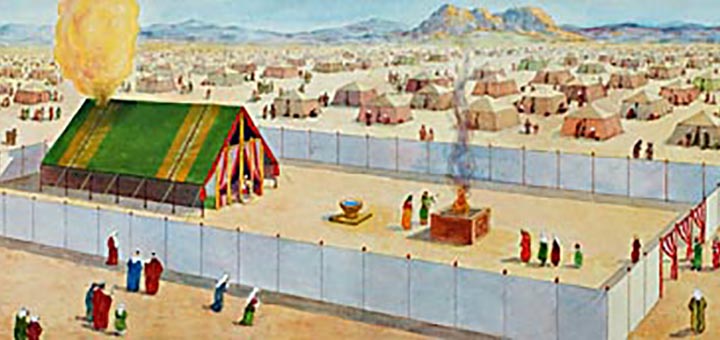What does it mean for the sanctuary be cleansed? Over the years, we have spent a great deal of time and effort to explain this process, with varying levels of success.
The discussion necessarily focuses on The Day of Atonement, which was seen even by the Israelites as symbolizing the ultimate remedy for the sin problem. And for varying reasons, the focus has been on the Altar of Incense. During the daily services of the tabernacle throughout the year, the blood of sacrifices came no further than the golden Altar of Incense. Only on the Day of Atonement did the blood of any sacrifice go inside the veil which separated the inner compartment of the tabernacle from the outer compartment.
Rather than focusing on the Altar of Incense, when I look at the service on the Day of Atonement, what jumps out at me is that this is the only time, the only service, which involves the entire sanctuary. To repeat, the daily services of the tabernacle halted at the veil, only on the Day of Atonement did the sacrifice go from the opening in the outer courtyard all the way into the Most Holy Place, the inmost portion of the sanctuary. On that basis, it appears to me that whatever “cleansing” means, it applies not to any single component of the tabernacle, but to the whole.
As I earlier mentioned, the focus has been on the accumulation of the sins of Israel, as represented by the blood placed on the Altar of Incense. And certainly, in the original context, that was the primary meaning. But if we as a people learned anything from the Great Disappointment, it would have to be that the “cleansing” that began on or about October 22, 1844, was not primarily about the Earth. That was the mistake the Millerites made, thinking that the sanctuary to be “cleansed” was on Earth. Hiram Edson’s insight that the focus of the prophecy was in heaven, rather than on Earth, gave hope to the “little flock,” and in a sense gave birth to what would become the Adventist Church.
This, however, leads to another question: Have sins somehow been “accumulating” in heaven? Remember, the earthly tabernacle “is a copy and shadow of what is in heaven” (Heb. 8:5). Does the sanctuary in heaven have wooden furniture? Some years ago a pastor confided that someone he was giving Bible studies to had asked that question. His reply was, “Don’t be silly, the furniture in heaven is pure gold!” Well . . . perhaps.
For myself, I have no idea if the heavenly sanctuary contains actual furniture–of wood or gold. I don’t think it matters, because I think the “pattern” in heaven is a functional pattern, not necessarily a literal one. The Altar of Burnt Offering represents Christ’s death on the Cross, an event–not a geographic location, or a physical device of any kind. If that is true, then I don’t see why any of the furnishings must be related to a physical piece of furniture. I have seen one argument that the lampstand–it wasn’t a candelabra–must be real because John saw it in vision in Revelation. That ignores the fact that those “sightings” are in the midst of highly symbolic passages.
We’re told that God is a spirit, whatever that means; I doubt a spirit needs a golden chair to sit in. But the metaphor or symbol of God’s “seat” of power is a throne, because we know what a throne is, and what it means. My point in all this is simple: there may be furniture of gold in heaven for us to see, or there may not be. The “pattern of the heavenly” essentially depicts how the plan of salvation works. Our prayers, like the incense in the Tabernacle, ascend into the very Presence of God. We can “boldly approach the throne of grace” in the same way the priest could walk into the Tabernacle and toward the Ark of the Covenant. The Lamb “as having been slain” is in the midst of the throne. And so on. Maybe there’s physical furniture there, I don’t know. What matters, it seems to me, is that God has given us a representation of the plan of salvation that helps build our faith.
So, what is really going on in heaven? It’s difficult to imagine sin accumulating there, so what has to be cleansed? As it turns out, “cleansed” is only one meaning of the actual Hebrew word sedeq. Like most words in any language, ṣedeq has a whole range of meanings. The King James renders ṣedeq as “cleansed.” But let’s look at other translations:
NIV: reconsecrated
NASB: properly restored
Jubilee Bible 2000: be justified
Darby Translation: vindicated
Young’s Literal Translation: declared right
Let’s look at those in turn. “Reconsecrated” does not make a lot of sense to me, since consecrate means to make or declare something sacred. Just as it is difficult to picture sin accumulating in heaven, it is difficult to imagine something profane being there. “Properly restored” might work, but it presents a similar difficulty to “reconsecrated,” that is, what is it that has been damaged or modified so that it needs to be “properly restored.”
The next three are quite similar: if something is to “be justified,” that’s very much like being “vindicated,” and both of those are quite close to being “declared right.”
So that leaves us with this question for next time: What is there in heaven that needs to be “properly restored,” “justified,” “vindicated,” and/or “declared right?” Is there any such thing? And if there is, what does that tell us about what took place in 1844?










